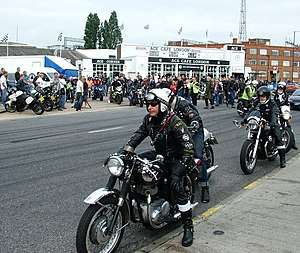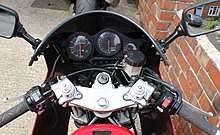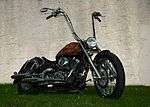Motorcycle handlebar
A motorcycle handlebar is a tubular component of a motorcycle's steering mechanism. Handlebars provide a mounting place for controls such as brake, throttle, clutch, horn, light switches and rear view mirrors; and they help to support part of the rider's weight. Even when a handlebar is a single piece it is usually referred to in the plural as handlebars.[1][2]

Construction
Handlebars are made from round-section metal tubing, typically aluminium alloys or chrome plated steel but also of carbon fibre and titanium, shaped to the desired contour. Holes may be drilled for the internal routing of control cables such as brake, throttle, and clutch. Risers hold the handlebars above their mounting position on the upper triple clamp[3] or the top of the fork, and may be integrated into the bar itself or separate items. Each handlebar end may contain bar-end weights to damp vibration by isolating the bar's resonant frequency from that of the engine.[4] Electrically heated grips may be fitted to provide warmth for the rider in cold weather.[5]
Sizes
There are several size parameters that describe most motorcycle handlebars:
- Width from grip to grip may vary from 30.5 to 37 inches (770 to 940 mm).
- May rise above triple clamp up to 24 in (610 mm) or more, called ape hangers when very high, or may drop a few inches below, called clubman bars.
- Pullback, the distance grips are behind their mounting location, may vary from 4.25 to 17 in (108 to 432 mm).
- Diameters vary; commonly 7⁄8, 1, and 1 1⁄4 in (22, 25, and 32 mm), though oversized bars of 1 1⁄4, 1 1⁄2, and 1 3⁄4 in (32, 38, and 44 mm) may reduce to 1 in (25 mm) at the grips so standard controls may be mounted.
Types of handlebars


Handlebars come in a variety of types designed for particular types of riding:
- "Ape-hangers" — found mainly on choppers, these are handlebars of such exaggerated height that the rider has to reach up to them, hence the name. Rumored to have originally been implemented to aid riders on motorcycles with no rear suspension to lift themselves from their seat to avoid potholes, they can also aid in a more comfortable ride since the riders hands are closer to shoulder height. However, if the position of the hands is higher than the shoulders, they may cause numbness in the hands, but the use of throttle locks or cruise controls may help alleviate such symptoms. Some jurisdictions restrict the maximum height of ape-hangers for safety reasons.[6]
- Beach bars — similar to cruiser bars, slope back toward the rider to allow a relaxed riding position.
- Buckhorn handlebars — similar to ape-hangers, but shorter and curved (thereby resembling a buck's horn). They are sometimes called "mini-apes" (miniature ape-hangers), but are not. Buckhorns have a different hand positioning than mini apes. The bar ends on Buckhorns are angled in and down towards the rider, mini apes hand positioning is out and more horizontal. A good example of buckhorn handlebars are the ones on Ghost Rider's Hellbike, from the 2007 movie Ghost Rider.
- Clip-ons — popular on sport bikes, in which two separate short handles are clamped directly to the fork tubes.[7][8] Adjustable or non-adjustable, these may be fitted above or below the triple tree. These two piece clip-on bars may also be attached to the top triple tree clamp and be non-adjustable.[9][10][11][12][13]
- Clubman bars — a one-piece handlebar mounted on the triple tree, reaching forward with ends slightly angled backwards to give the rider a lower, more crouching riding position. Common on café racers in the UK, Clubman bars are sometime known as "Thruxton bars" or "Thruxton drops" (after the Thruxton race circuit);[14][15][16] or "Ace bars" (after the Ace Cafe on the North Circular Road in London).
- Cruiser handlebars — long and slope towards the rear of the motorcycle so that the rider can sit upright.
- Drag bars — nearly straight across to create a forward-leaning and aerodynamic riding position.
- Motocross bars — motocross, off-road, and dual-sport motorcycles normally have tubular bars with a cross-brace to resist torsional twist.
- Z-bar — any sharply angled handlebar with either long or short straight rise sections, which are sharply angled upward from the mounting points and again sharply angled to the handgrip and control area.
- T-bar - similar to drag bars, but have built in risers which create the look of a 'T'. This modifies the riding position from the forward leaning drag bar to a more relaxed riding position.
See also
References
- "handlebar". Oxford English Dictionary (2nd ed.). Oxford University Press. 1989.
- "Handlebar". Dictionary.com Unabridged. Random House. Retrieved 2015-01-03.
- The fork-tubes are held in place by an upper and lower "triple clamp" (or "yoke" in the UK). The whole assembly is called a "triple tree".
- Bikes Media
- MCN Review
- http://legis.state.sd.us/statutes/DisplayStatute.aspx?Type=Statute&Statute=32-20-3
- The Motor Cycle, 17 July 1952, p.23 (supplement ix) Classified advertising: RACING MOTOR CYCLES. "1950 Norton 350, double knocker, clip-on fork bars, 19in wheels, Grand Prix carb, engine 100%, machine in immaculate condition, ready to race; £300.—John Surtees, Junr., 2, Palace Green, Addington, Surrey. Springpark 3363". Accessed February 26, 2018
- Métisse clip-ons
- Brissette, Pete (April 23, 2008). "2008 Hayabusa vs. ZX-14R Shootout". Motorcycle.com. Retrieved December 30, 2016.
- "2008 Buell Firebolt Review". Motorcyclist. March 19, 2013. Retrieved December 30, 2016.
- Canet, Don (August 28, 2007). "First Ride: 2008 Buell 1125R". Cycle World. Retrieved December 30, 2016.
- Adams, Adams (March 17, 2014). "Five Sport-Touring Upgrades for the Suzuki Hayabusa". Sport Rider. Retrieved December 30, 2016.
- Duke, Kevin (November 17, 2004). "2004 Buell XB12R Firebolt". Motorcycle USA. Retrieved December 30, 2016.
- The Motor Cycle, 22 March 1962, p.4 Halfords advert "Handlebar bends. Club Ace dropped pattern Junior size 15/6, Club Ace Senior pattern 17/6. Prices correct at time of going to press 16 March 1962". Accessed January 21, 2018
- Motorcycle Mechanics, July 1964, pp.30-31 "For getting down to it, a range of bars is available. The 'Thruxton' costs 21s., the adjustable type is 48s. 6d. and the straight clip-ons 37s. 6d.". Accessed January 21, 2018
- Motorcycle Mechanics, October 1969, p.13 Pride and Clarke single-page advert, Thruxton drops 7⁄8 in 29/6, postage 5/6. Accessed January 29, 2018